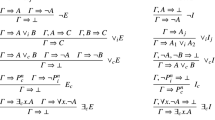Abstract
Motivated by semantic inferentialism and logical expressivism proposed by Robert Brandom, in this paper, I submit a nonmonotonic modal relevant sequent calculus equipped with special operators, □ and R. The base level of this calculus consists of two different types of atomic axioms: material and relevant. The material base contains, along with all the flat atomic sequents (e.g., Γ0, p |~0 p), some non-flat, defeasible atomic sequents (e.g., Γ0, p |~0 q); whereas the relevant base consists of the local region of such a material base that is sensitive to relevance. The rules of the calculus uniquely and conservatively extend these two types of nonmonotonic bases into logically complex material/relevant consequence relations and incoherence properties, while preserving Containment in the material base and Reflexivity in the relevant base. The material extension is supra-intuitionistic, whereas the relevant extension is stronger than a logic slightly weaker than R. The relevant extension also avoids the fallacies of relevance. Although the extended material consequence relation is defeasible and insensitive to relevance, it has local regions of indefeasibility and relevance (the latter of which is marked by the relevant extension). The newly introduced operators, □ and R, codify these local regions within the same extended material consequence relation.
Access this chapter
Tax calculation will be finalised at checkout
Purchases are for personal use only
Similar content being viewed by others
Notes
- 1.
This is a product of our collaborative work with Robert Brandom’s research group. The technical results reported here are mine.
- 2.
This indefeasibility box and the mechanism that makes it work are proposed by Hlobil [6].
- 3.
- 4.
Two more comments are in order for LLC1 and LLC2. First, it may be unnoticeable how LLC2 differs from LLC1. The only formal difference is that the left top sequent of LLC2 must be relevant, while the corresponding sequent of LLC1 need not. This requirement on LLC2 is crucial for R to codify what it is supposed to codify (see Proposition 12 below). Second, given that the indexed upward arrow is supposed to mark sets of non-defeaters of a given implication, one may find the upward arrow of the bottom sequent of LLC1 and LLC2 (i.e., ↑X[/Y]) counterintuitive. Upon closer look, however, there is no substantial harm here. After all, if the bottom sequent is non-relevant, then it is supposed to hold indefeasibly (remember that the right top sequent must be flat, and therefore is supposed to hold indefeasibly). If the bottom sequent is relevant, on the other hand, both right and left top sequents must also be relevant. Then, both indices of those top sequents (i.e., ↑X and ↑Y) must be the empty set, since PushUpUN has no application in relevant sequents. The technical advantage of the current formulations of LLC1 and LLC2 are substantial. They enable us to prove the admissibility of restricted versions of Cut in NMMR (see Proposition 7 below).
- 5.
Recall that it is syntactically stipulated that X ⊆ P(L0).
- 6.
- 7.
- 8.
A note on the intended reading of this biconditional: It is optional whether the left-hand sequent is relevant, while the right-hand sequent must be relevant.
References
Anderson, A.R., Belnap, N.D.: Entailment: The Logic of Relevance and Necessity, vol. I. Princeton University Press, Princeton (1975)
Anderson, A.R., Belnap, N.D., Dunn, J.M.: Entailment: The Logic of Relevance and Necessity, vol. II. Princeton University Press, Princeton (1992)
Brandom, R.: Making It Explicit. Harvard University Press, Cambridge (1994)
Brandom, R.: Articulating Reasons. Harvard University Press, Cambridge (2001)
Brandom, R.: Between Saying and Doing: Towards an Analytic Pragmatism. Oxford University Press, Oxford (2008)
Hlobil, U.: A nonmonotonic sequent calculus for inferentialist expressivists. In: Arazim, P., Dančák, M. (eds.) The Logica Yearbook 2015, pp. 87–105. College Publications, London (2016)
Mares, E.: Relevance logic. In: Zalta, E.N., Nodelman, U., Allen, C. (eds.) Stanford Encyclopedia of Philosophy (2012). http://plato.stanford.edu/archives/spr2014/entries/logic-relevance/. Last accessed 27 Feb 2016
Author information
Authors and Affiliations
Corresponding author
Editor information
Editors and Affiliations
Rights and permissions
Copyright information
© 2017 Springer-Verlag GmbH Germany
About this paper
Cite this paper
Shimamura, S. (2017). A Nonmonotonic Modal Relevant Sequent Calculus. In: Baltag, A., Seligman, J., Yamada, T. (eds) Logic, Rationality, and Interaction. LORI 2017. Lecture Notes in Computer Science(), vol 10455. Springer, Berlin, Heidelberg. https://doi.org/10.1007/978-3-662-55665-8_39
Download citation
DOI: https://doi.org/10.1007/978-3-662-55665-8_39
Published:
Publisher Name: Springer, Berlin, Heidelberg
Print ISBN: 978-3-662-55664-1
Online ISBN: 978-3-662-55665-8
eBook Packages: Computer ScienceComputer Science (R0)





